| |||||||
| Search Forums |
| Advanced Search |
| Go to Page... |
 |
| Search this Thread |  75,862 views |
| | #16 |
| BANNED Join Date: Dec 2007 Location: Gurugram
Posts: 7,969
Thanked: 4,789 Times
| Re: Boeing 747: End of the Jumbo Jet era? By the looks of it the hub and spoke model is being replaced by the point-to-point model. Yes, it seems that the Boeing strategy of not going for the super-Jumbo may have been correct. What may happen is that the super-jumbo may find application in freight, and selected applications. There are plenty of places where the hub and spoke model is still applicable. |
| |  (2)
Thanks (2)
Thanks
 |
| The following 2 BHPians Thank sgiitk for this useful post: | GTO, libranof1987 |
| |
| | #17 | ||
| BHPian Join Date: May 2008 Location: Bay Area, CA
Posts: 75
Thanked: 157 Times
| Re: Boeing 747: End of the Jumbo Jet era? Quote:
That said, even if there was a provision for internal fuel, it would not probably be enough. To get into orbit (as opposed to a sub-orbital flight) the vehicle has to be travelling fast (at least 8km per second), not just high (space starts at 100km altitude). Launching from high altitudes does give some fuel savings (about 8-10% IIRC) but not enough to make a significant difference compared to a vertical launch using solid rocket boosters. XKCD's What-if series has a great explanation of the question "Could a (small) rocket (with payload) be lifted to a high point in the atmosphere where it would only need a small rocket to get to escape velocity?". Quote:
Airlines negotiate with (or even invest in) large airports where they operate a hub for low parking fees, landing fees, take-off fees and fuel. At hubs airlines also usually operate their own ground services avoiding the costs of external contractors. Next, the hub and spoke model allows airlines to minimize the types of aircraft they have in operation - one high-capacity long-range design (eg. 777,767,A330), another medium-range narrow body (eg. 737, A320) and occassionally a commuter-liner for really low-capacity routes (eg. E190, CRJ). The fewer types of aircraft the airline has in operation, the lower are their maintenance, inventory and crew training costs. Larger numbers of a similar type also allow them to drive volume discounts from aircraft manufacturers. | ||
| |  (8)
Thanks (8)
Thanks
 |
| The following 8 BHPians Thank vivtho for this useful post: | deetjohn, dreamliner17, gthang, GTO, JoseVijay, LordSharan, pankaj_sachdeva, The Rationalist |
| | #18 | ||
| Distinguished - BHPian  Join Date: Aug 2014 Location: Delhi-NCR
Posts: 4,072
Thanked: 64,360 Times
| Re: Boeing 747: End of the Jumbo Jet era? Quote:
Quote:
| ||
| |  ()
Thanks ()
Thanks
 |
| | #19 |
| BHPian Join Date: Sep 2011 Location: Delhi/Mumbai
Posts: 683
Thanked: 697 Times
| Re: Boeing 747: End of the Jumbo Jet era? 747-8 and 9 are very much in the making and more advanced that earlier generation planes. These variants will be fuel efficient too. So its not going to be extinct anytime soon! In addition, the new Air Force Ones will be 747-8 too. |
| |  (1)
Thanks (1)
Thanks
 |
| The following BHPian Thanks avingodb for this useful post: | GTO |
| | #20 | |
| Senior - BHPian Join Date: Mar 2006 Location: mumbai
Posts: 2,135
Thanked: 2,998 Times
| Re: Boeing 747: End of the Jumbo Jet era? Quote:
| |
| |  (1)
Thanks (1)
Thanks
 |
| The following BHPian Thanks apachelongbow for this useful post: | GTO |
| | #21 | |
| BHPian Join Date: Jan 2015 Location: Auroville
Posts: 94
Thanked: 164 Times
| Re: Boeing 747: End of the Jumbo Jet era? My two cents about the issue.. The B747 series has been in service since the 1970's and it can't be called anything but 'numero uno' in the services that it is rendered, for both freight and passenger operations. It seems to be long in the tooth now but it still has some juice left, IMHO. I agree with the fact that an aircraft has a small shelf life and an aircraft completing 45 years of service is on the verge of a phase out, but the B747 has always given more than what it might have intended to. Come 2005 and we see a rival to the B747, though it seems that the A380 sees a bleak future ahead with the A330/B777 making a comeback and also after the introduction of the B787 Dreamliner. With Emirates still betting on the A380, i feel they want this tag of owning the 'largest fleet of the largest aircraft', for reasons that may be more of aesthetics than practicality. On the other hand, when you do have to transit Dubai for transfer flights, you will realize that Dubai does require A380 to ferry soo many people who are basically employed in Dubai and keep visiting back to their native land  For the freighter markets (say for a dedicated cargo company Cargolux), the transition from the B747 to the A380 freighter might take up more time than expected, just because leasing the 747 might be cheaper compared to leasing/buying the A380 freighter version. Quote:
Any kind of technological advancement might suffer from a 'ping-pong' effect where the developer will always be in a fix to either increase raw power from higher capacity or generate high power from lesser capacity. In short it will always be a battle of Efficiency vs Power. We have around 19,000TEU as the max capacity for shipping liners, but how many companies can we see investing in such humongous ships! | |
| |  (2)
Thanks (2)
Thanks
 |
| The following 2 BHPians Thank dreamliner17 for this useful post: | D33-PAC, GTO |
| | #22 |
| BHPian Join Date: Feb 2012 Location: New York City
Posts: 170
Thanked: 634 Times
| Re: Boeing 747: End of the Jumbo Jet era? The 747-8 is unfortunately a band-aid sort of reaction to the A380. The main reason the A380 is suffering is the financial slump of the late 2000's which led to order postponement and cancellations. You can rest assured that there will be a -NEO or New Engine Option version of the 380 with improved engines that make it more efficient soon. Airbus and Boeing are both learning from their A350's and 787's. If you think about it, these are the only two radically new planes with different materials and wing designs. Expect these ideas to pass on to the rest of the airline world slowly but surely. India and China are actually the future for super-sized aircraft. With 2.7 billion people, you need big aircraft doing big routes. This is why Emirates had to change one of their DXB-BOM routes to an A380 even though it is just 2.5 to 3 hours long. Further, they fly FIVE wide body services to and fro each day. As passenger numbers rise, we will need more and more big services of 550 seats plus. If an airline configures the A380 with only Business + Economy it'd have 600 seats. Finally, the A380 is suffering because of airport constraints. Currently Bombay has only ONE bay to park an A380 which will eventually become four. I can easily imagine trunk routes like New York and London being operated by A380's in the near future as more Indians take to the sky. Airports like Bombay have one main runway so one would theoretically prefer 600 people per landing than 250-300, even though there is slightly longer separation required for A380's to land. Time will tell, but the era of the superjumbo is not even close to over. |
| |  (5)
Thanks (5)
Thanks
 |
| The following 5 BHPians Thank carmayogi for this useful post: | Akshay1234, deetjohn, GTO, pankaj_sachdeva, V.Narayan |
| | #23 |
| BHPian Join Date: Mar 2013 Location: Stockholm
Posts: 85
Thanked: 39 Times
| Re: Boeing 747: End of the Jumbo Jet era? If you live in a 3 BHK house, you will not purchase the 4th air conditioner, unless you move to a new house or build another room in your existing house (Of course, you may upgrade one of them).  The airlines industry have hubs/transits and long haul (read jumbo) aircraft start from different parts of the world to transfer people some half of the journey. Till new hubs keep coming up (do/will they?), jumbo flights will keep registering their sales, albeit small figures. Jumbos are also used for small haul flights as well to satisfy the demand & supply part. The increasing airtime and the social responsibility stuff (CO2 emissions, etc.) kind of perform a balancing act (I hope). Quick  There is a joke for environmentalist from all over the world to have flown to some corner of the world to discuss what they discuss best! lol There is a joke for environmentalist from all over the world to have flown to some corner of the world to discuss what they discuss best! lolNow the question is: A333s/340s and B777s/787s can also do this job, ain't it? So it all boils down to the carrier to decide. For example, Bengaluru to Frankfurt which has the world's longest jumbo in service. And then we have the codeshare part to compliment. Having jumbos in product portfolio does not guarantee their recurring sales year after year. I am pretty sure Boeing & Airbus already knew this, and knew this well. Their motto was to build efficient machines, which they did. Carry same or more passengers/freight and yet pay less in aviation fuel. So I do not think jumbos will become history in coming years. The freight versions, as someone said, will continue to be in demand. Here are some of the statistics shown in Wiki, which some of you might have seen. 747-8 orders & delivery  Maybe some of the existing 747-4 customers may trade off with its newer bigger sibling in years to come. A380 order & delivery  Airbus did a good job to advertise the incoming jumbo. They took orders way before the jumbo became flight ready. |
| |  (2)
Thanks (2)
Thanks
 |
| The following 2 BHPians Thank nkishore_007 for this useful post: | GTO, sri2012 |
| | #24 |
| Distinguished - BHPian  Join Date: Aug 2014 Location: Delhi-NCR
Posts: 4,072
Thanked: 64,360 Times
| Re: Boeing 747: End of the Jumbo Jet era? Just for interest of aviation enthusiasts putting down below the major variants of the 747 for interests sake. I am sure there are several commercial pilots on Team BHP and their valuable inputs will be most welcome. This is not meant to be a technical write up and is a simple photo essay to enjoy on a Sunday afternoon. 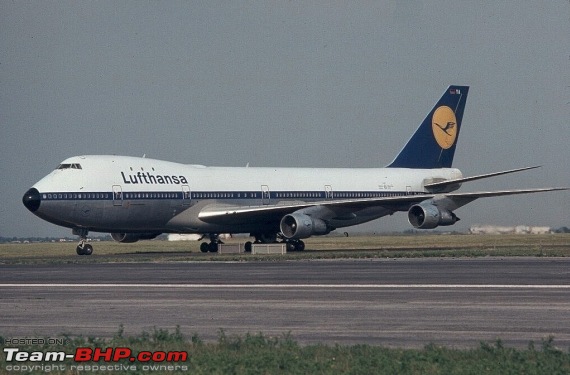 1969: First came the 747-100 which was the base version you could say and could carry 380+ passengers in a 2 class configuration (first and economy). The early customers were Pan Am, Lufthansa, American Airlines and others. Note the few windows on the upper deck - this was a first class lounge as the deck had not been certified for passenger carriage while taking off and landing.  1969: Photo of the test crew flying the prototype on 9th February 1969. 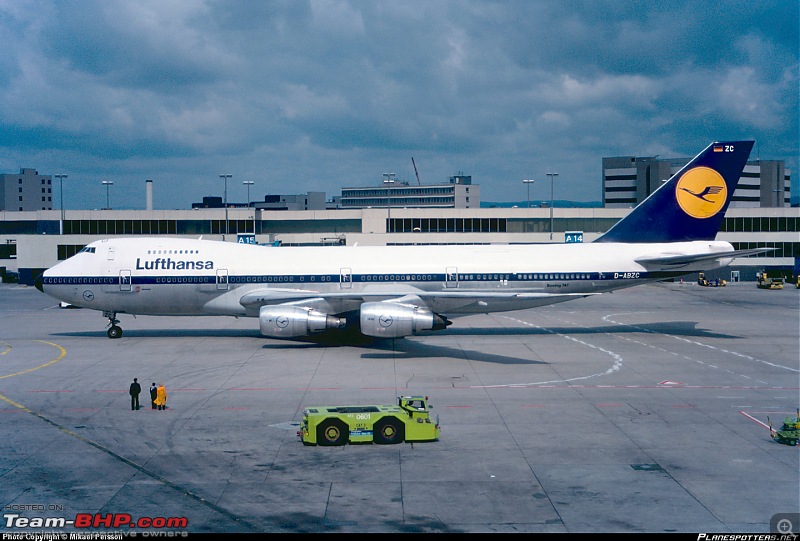 1971: The 747-200B was the definitive passenger version with higher all up weights giving longer ranges with a full passenger payload (11,000 kms brochure range; 10,000 kms would be more practical) or be able to carry a full passenger load and a full cargo load over more common routes of 7500 kms (Delhi-London for example). Later -200Bs had the upper deck also used for regular passenger seats and the lounge went out. Interestingly it was the capaciousness of the 747 that led British Airways to experiment with a 'Executive Class' in between First and Economy for the first time in early 1970s. Other airlines followed suit. 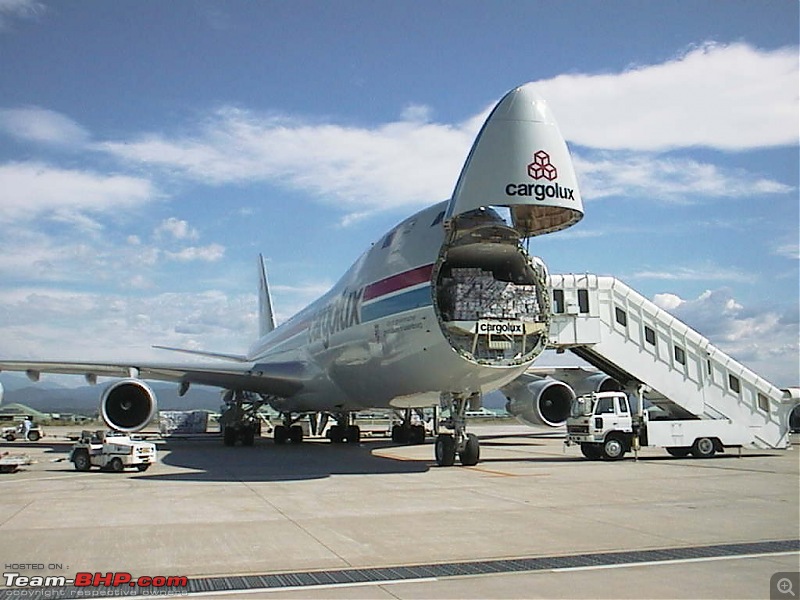 1971: The all freighter version came in 1971 with Lufthansa. Its carrying capacity was three times the all freighter version of the Boeing 707. For two years the first aircraft delivered to Lufthansa remained the sole 747 freighter in service world wide. Air cargo traffic took a while to catch up with this new giant. 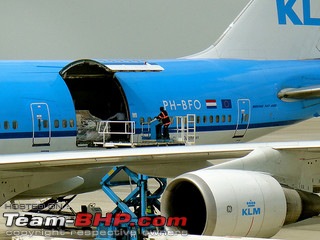 1973: Boeing introduced the 747-200C ie the 'Convertible'. The main passenger deck could be configured for either an all passenger or an all cargo configuration. This was supposed to give airlines flexibility of use. It did not prove to be popular. 1974: The Convertible, above, gave rise to the Combi at the initiative of Sabena (the then Belgian airline). The Combi, or the 747-200M, carried passengers in the front on the main deck and cargo at the aft plus on the second deck below. This proved to be a winner. The relative volume of the passenger and cargo compartments could be varied. Photo above of a Combi with a rear loading cargo door. 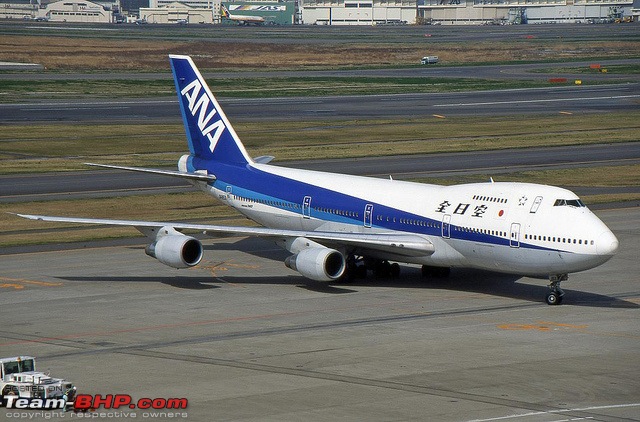 1973: Responding to requests from Japanese airlines for a high-capacity aircraft to serve domestic routes between major Japanese cities, Boeing developed the 747SR as a short-range variant of the 747-100 with lower fuel capacity and greater payload capability. With all economy class seating, up to 498 passengers could be carried in early versions and more than 550  in later models. The 747SR had an economic design life objective of 52,000 flights during 20 years of operation, compared to 24,600 flights in 20 years for the standard 747 reflecting the need for shorter flight cycles. Extra structural support was built into the wings, fuselage, and the landing gear to accommodate the added stress accumulated from a greater number of takeoffs and landings along with a 20 percent reduction in fuel capacity. in later models. The 747SR had an economic design life objective of 52,000 flights during 20 years of operation, compared to 24,600 flights in 20 years for the standard 747 reflecting the need for shorter flight cycles. Extra structural support was built into the wings, fuselage, and the landing gear to accommodate the added stress accumulated from a greater number of takeoffs and landings along with a 20 percent reduction in fuel capacity. 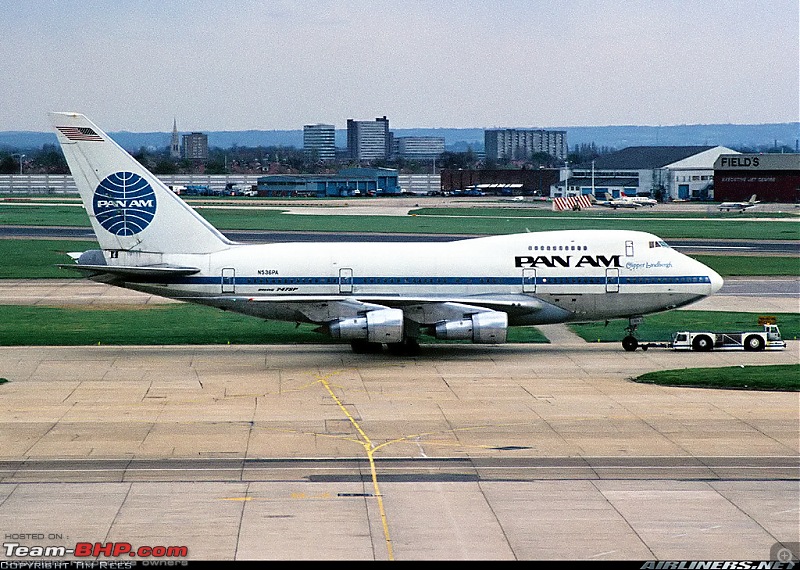 1975: Boeing then introduced a shorter fuselage, lighter weight longer range derivate named 747SP. Its stubby shorter fuselage is apparent in the photo. It could carry a full load of ~250 passengers over 12,000 kms and was popular with airlines needing long legs - Quantas, Pan Am, South African Airways (in days of apartheid when they were not allowed to land in other African countries) and so on. Economics suffered due to the same engine power carrying fewer passengers but those who needed to range on thin long routes bought it. 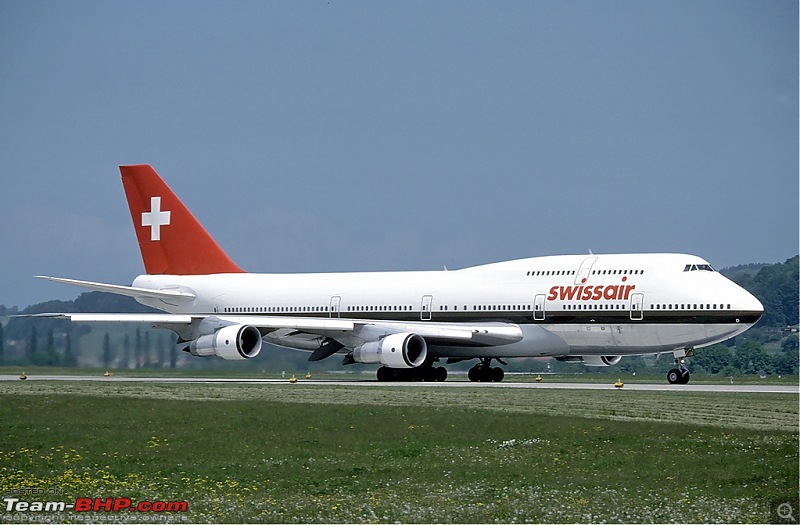 1983: The 747-300 came in with a stretched upper deck that added passenger capacity in a world where at last the 747's were flying full load. Interestingly the streamlined upper structure improved cruise speed from Mach 0.83 to Mach 0.85. The slowdown in the aviation industry in the mid-1980s saw production of the 747 drop from 7 a month in 1980 to 1 a month in 1983. Production crises' are not unique to the A380 alone it is a part and parcel of this industry. 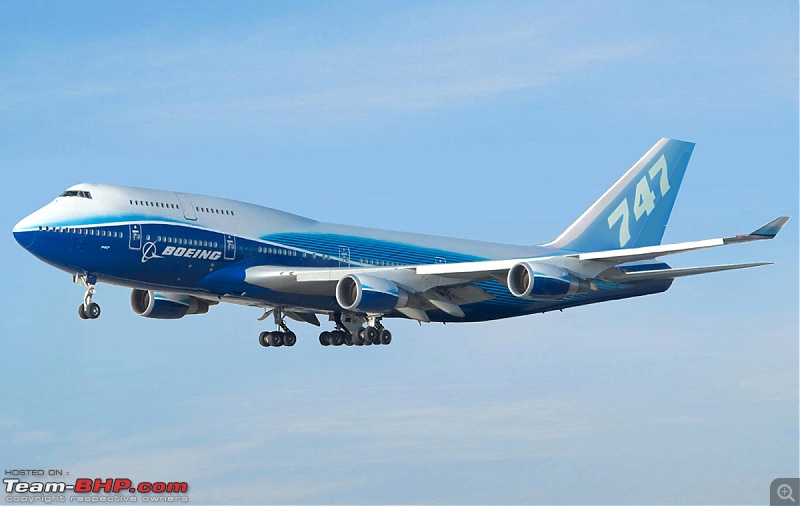 1989: Boeing came out with the 747-400 family which was a step ahead of the earlier 747-200 and 747-300 range. The cockpit was converted from a 3 crew to a 2 crew one, the number of switches and dials reduced from 971 to 365 (still a lot of work though for the crew of two), 6 feet high winglets were added to reduce fuel burn and enable cruising at higher altitudes (in colder thinner air), weight saving composites were included in the airframe and wing structures, a fuel tank was added in the tail plane and several other such improvements. All freighter and Combi versions were built and the -400 accounts for about half of all 747s built. The 747s BHPians typically see today are most often -400s. Seen here is the first -400 on its first test flight. On first test flights the landing gear is never raised - you don't want the risk of losing the first prototype if the gear fails to open up properly on landing. 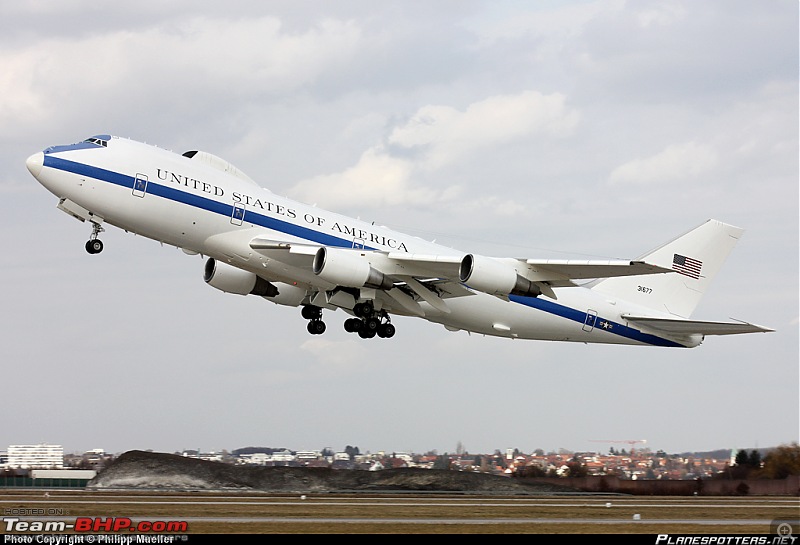 The E-4A's: These are US Govt national command posts to carry the executive members of the US Govt in times of a nuclear crises. The aim is to provide a safe haven in the skies at least partly shielded from the radiation of nuclear warheads and equipped lavishly with communication aids. Hopefully these should never be used.  SOFIA: And finally there is the unique version which is a flying astronomical observatory. This aircraft flies above 40,000' to reduce the effect of atmospheric distortion allowing a 98" diameter infra red telescope to acquire clearer images of astronomical objects than is possible from ground based observatories. The technical challenges to make this work successfully have been enormous and though limited astronomical work has been done continuously since 2010 it was only in 2014 that the system was fully operational and is now facing budget cuts. 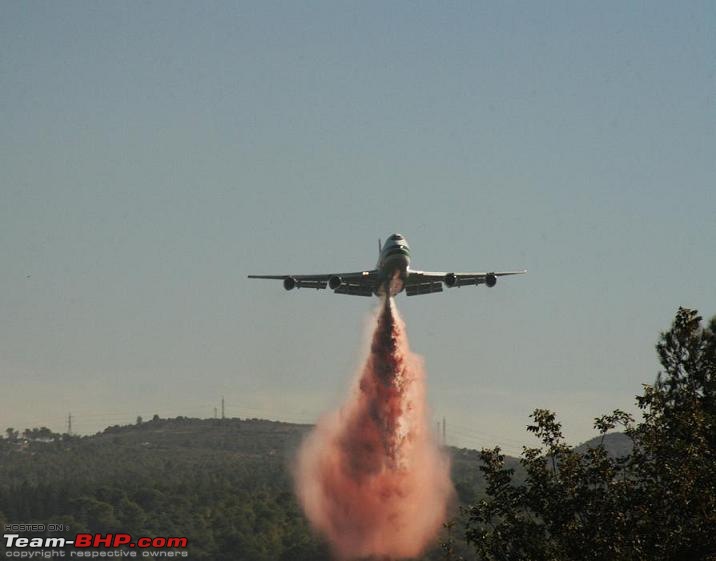 2002: And finally old 747s are being converted to forest fire fighters. Their huge volume and lift capacity make them especially efficacious. 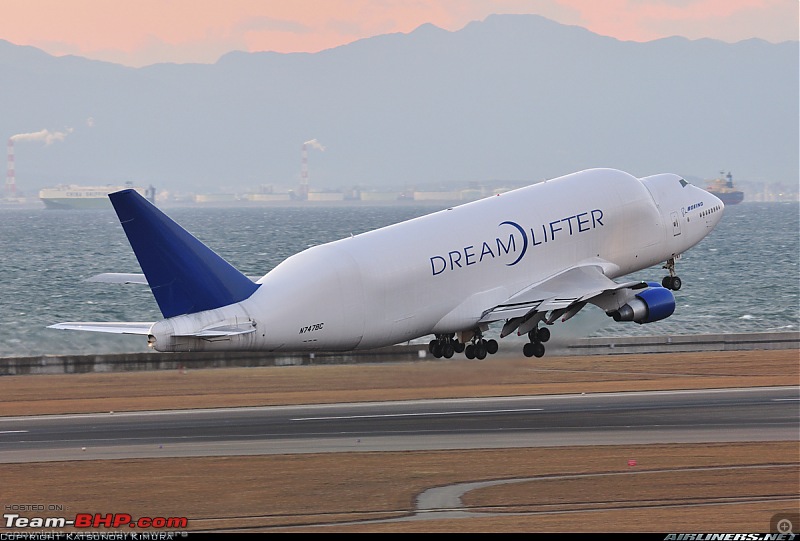 2006: Boeing converted four existing 747s into this bulbous cargo carrier to transport outsize airframe parts from de-centralized manufacturing locations of the Boeing 787 to the assembly plants. Airbus have a similar machine called the Beluga. This Boeing variant is named Dreamlifter. Scott Carson who designed the modification to create this Dreamlifter apologized to Joe Sutter the original father of the 747 " for what we did to your airplane....but we've applied paint on it though its a bit like putting lipstick to a pig" 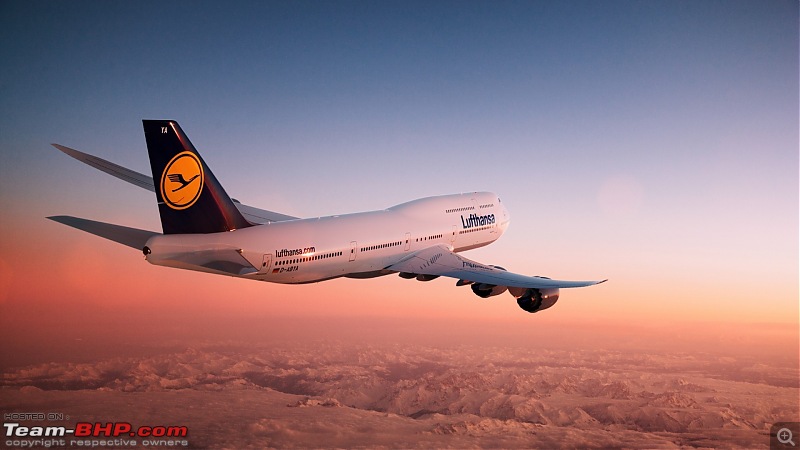 747-8: The current production version. In service with Lufthansa. Future uncertain. But a touchingly beautiful aeroplane all the same. Note how the wings flex up to give better aerodynamic efficiency. 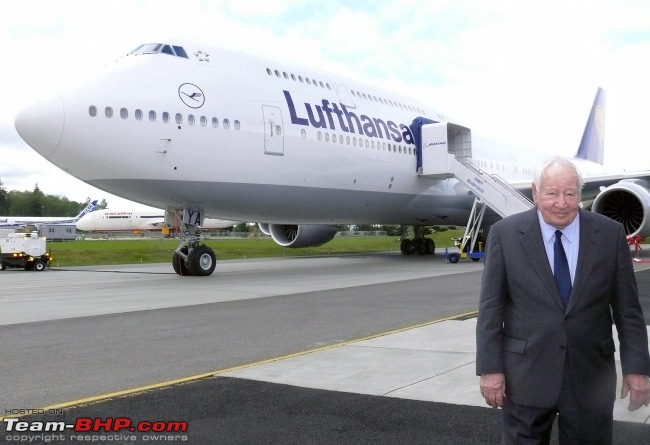 2012: Lufthansa honoured Joe Sutter the chief designer of the 747 with a life time achievement award when it took delivery of the first 747-8 PS: I have left out the US Air Force One version which almost all BHPians would know of and the Space Shuttle carrier covered in an earlier post Last edited by V.Narayan : 19th April 2015 at 14:53. Reason: additions |
| |  (47)
Thanks (47)
Thanks
 |
| The following 47 BHPians Thank V.Narayan for this useful post: | arunphilip, avingodb, azeemhafiz, benbsb29, carmayogi, deetjohn, dreamliner17, Eddy, fiat_tarun, GForceEnjoyer, gthang, GTO, guyfrmblr, honeybee, IcarusMan, InControl, JoseVijay, kevintomin, libranof1987, moralfibre, Mtv, myavu, MyLife_MyCar, nkishore_007, OverKill, pankaj_sachdeva, racer_m, raghuvir, raihan, RGK, Roy.S, sajusherief, SmartCat, sri2012, sriramr9, Tejas@perioimpl, TheARUN, tsk1979, v1p3r, vb-saan, Viju, vinayrathore, vipulbatta, Vishal.R, vnabhi, WAM-4, wbd8779 |
| | #25 |
| Distinguished - BHPian  Join Date: May 2010 Location: Bengaluru
Posts: 4,220
Thanked: 5,899 Times
| Re: Boeing 747: End of the Jumbo Jet era? Thank you Narayan for the beautiful insight into the various 747 sub models. Airlines now want fuel efficient aircraft's.Airline industry is obsessed with 'Kitna Deti Hai' like we Indians. The latest version of 777 ER(Triple Seven as its popularly called) has the same range as the 747-8 , burns 40% less fuel and carries just 15% less passengers than the 747. This is a huge saving for any airline. So its not a difficult business decision for an airline to choose 777 over 747. Further , Lufthansa is the main user of the 747-8 with the FRA-BLR being one of the main sector being flown by these beauties.It is also a fact that on the assurance from Lufthansa that it will buy a fleet of the 747-8 , did boeing start the development of the latest model . Also the major %age of these aircraft's are freighter versions. The Airbus A380 got off to a flying start(pun intended) mainly due to the novelty it offered and the large seat capacity.However no airline has utilized the aircraft to its max seating capacity. If not for the Oil rich gulf countries, the project would have been a big failure. Emirates has the biggest fleet of these super jumbos. But now the orders have dwindled and no orders have been placed so far in 2015. But Airbus does have a backlog of around 100 of the A380 aircraft's. In conclusion, airlines want efficient aircraft's and people want low priced air tickets. This will not be possible with gas guzzling aircraft's. Hence the trend towards smarter and more fuel efficient aircraft's. |
| |  ()
Thanks ()
Thanks
 |
| | #26 |
| Distinguished - BHPian  | Not sure if the the 747-8 is the latest production version, or at least I was under the impression the 747-4 was still produced as well. The 747-8 is also the first 747 with Fly by wire. The white house recently announced purchasing several of these 747-8s replacing the current fleet of presidential jumbo's (i think those are still 747-2's?). Time moves on, but i have always been hugely impressed with the 747. I remember the first one arriving at Schiphol, now Amsterdam airport. It drew huge crowds. My dad took me and all my friends to go and see. Im still heavily into the 747-400. Have been studying the design, maintenance and operations for decades now! Still learning. Jeroen |
| |  (1)
Thanks (1)
Thanks
 |
| The following BHPian Thanks Jeroen for this useful post: | sriramr9 |
| |
| | #27 |
| BHPian Join Date: Sep 2011 Location: Delhi/Mumbai
Posts: 683
Thanked: 697 Times
| Re: Boeing 747: End of the Jumbo Jet era?
Thanks for the info Narayan. Actually, I think the 747-400 pic you posted is not right. Boeing came up with this colour scheme only after 2000 I guess. Here is the pic I got of the test flight from the net. The first -400 was named N401PW |
| |  ()
Thanks ()
Thanks
 |
| | #28 | |
| BHPian Join Date: Oct 2009 Location: KA51/KL03
Posts: 923
Thanked: 862 Times
| Re: Boeing 747: End of the Jumbo Jet era? Quote:
The aircraft shown in the picture is a 744, but you are right that this is not the first 744. And "N401PW" is not the name, but the registration. | |
| |  ()
Thanks ()
Thanks
 |
| | #29 | |
| BHPian Join Date: Apr 2011 Location: Chennai, Canada
Posts: 216
Thanked: 46 Times
| Re: Boeing 747: End of the Jumbo Jet era? Quote:
More over my gut feeling is, 707's were still around when the -100 s were introduced and other airline companies were not driving Boeing to build a Jet of Jumbo size except for Pan Am, That could have been an other reason. | |
| |  ()
Thanks ()
Thanks
 |
| | #30 | |
| Senior - BHPian Join Date: Feb 2006 Location: Bangalore
Posts: 1,042
Thanked: 196 Times
| Re: Boeing 747: End of the Jumbo Jet era? Quote:
The DC-10 also had a very troubled launch as an unreliable aircraft. Due to a cargo door issue. I think L-1011 was the most reliable of the lot however a scandal involving the management bribing the Japanese government brought down its reputation. 747s also had a cargo door issue but was noticed only in 1989 due to explosive decompression of a US airliner (United I think). In 1996 a 747-100 exploded mid air due to a short circuit in the fuel tank, apparently boeing took more than 12 years to fix it. | |
| |  (1)
Thanks (1)
Thanks
 |
| The following BHPian Thanks cooldude1988765 for this useful post: | sriramr9 |
 |



